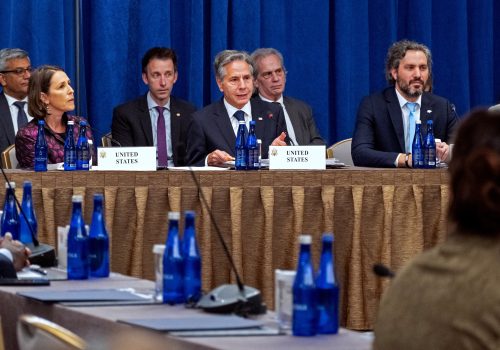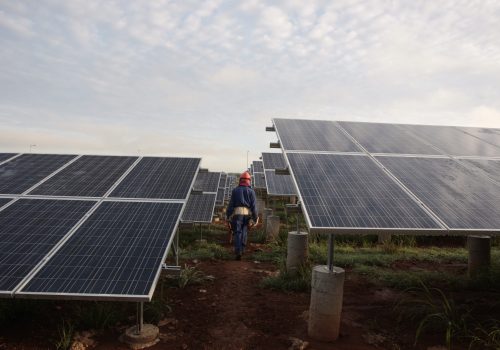The APEP Leaders’ Summit opened a window for deeper US economic ties with Latin America and the Caribbean
Half of the United States’ free trade partners are Latin American countries, with hemispheric neighbors comprising eleven of the United States’ top forty-five export partners. Amid rapid global transformations, US economic security will increasingly be tied to economic prosperity in the Americas and ensuring that the United States is a strategic partner in defining that economic future. These are some of the reasons why it was a big deal that, for the first time in recent memory, a sitting US president convened a White House summit with eleven of the United States’ hemispheric partners.
The Americas Partnership for Economic Prosperity (APEP) Leaders’ Summit was held on November 3. It zeroed in on advancing responsible, sustainable investment and accelerating new commercial flows. In advancing the summit’s focus on prosperity, leaders worked on creating a roadmap to foster regional competitiveness, make supply chains more resilient, and mobilize new sustainable investment across the hemisphere.
The initial partners of APEP are a select group of ten Latin American and Caribbean countries, as well as Canada and the United States. Together, these countries represent about 90 percent of the Western Hemisphere’s gross domestic product. More importantly, the United States has trade agreements with eight of these countries, which gives APEP an underlying institutional framework in which to operate. For the APEP to yield results over time, however, the initiatives announced at the summit must be accompanied by ambitious trade integration efforts, targeted investment goals, and an expansion of the countries included in the partnership.
The motivation behind the summit
The Biden administration’s push to increase the United States’ economic presence in Latin America and the Caribbean (LAC) comes at a critical time in hemispheric relations, as Chinese influence in the region has dramatically increased over the last decade. Whereas China imported 1 percent of the region’s exports in 2000, it now imports 15 percent. Chinese companies are also major investors in the energy and infrastructure sectors, as China’s Belt and Road Initiative has found many partners in Latin America, including among at least eight APEP member countries. The region’s trade flows have shifted toward Beijing, and China has surpassed the United States to become South America’s largest trading partner. LAC governments, in turn, have criticized the United States for remaining an observer to this trend, unable or unwilling to match Chinese influence with a cohesive economic policy that offers alternatives to regional policymakers. The APEP Leaders’ Summit represented the United States’ effort to rise to the occasion and to further position itself as an attractive partner to LAC countries.
What the summit accomplished
At the APEP Leaders’ Summit, US President Joe Biden announced new initiatives and programs that seek to define the pillars of US economic engagement with the region for years to come. The focus of the new hemispheric economic policy is on development financing and mobilizing new, sustainable investment in the region, with the Inter-American Development Bank (IDB) taking on a central role.
Among the most prominent announcements at the summit, the US International Development Finance Corporation (DFC) and the IDB will launch an investment platform to channel “billions of dollars into building sustainable infrastructure and strengthening critical supply chains.” By mitigating investment risk, the White House aims to unlock barriers to private sector financing in the region. Moreover, Biden announced that the United States will work with the IDB to establish a fund for nature to mobilize more investment in climate-based solutions, such as debt-for-nature swaps, as well as blue and green bonds. Other initiatives to enhance workers’ skills in the region and to benefit migrant-hosting countries were also announced. The announcements are welcome, but what will be most important is ensuring that the new money and financing opportunities actually reach the region and the people whose lives could be most improved by these initiatives.
Assessing the APEP summit
The summit shows the United States’ intention to deepen economic cooperation with the region, even amid geopolitical crises that might otherwise eclipse the US government’s capacity to offer a cohesive economic policy approach.
Mobilizing new development finance and sustainable investment, including the new initiatives announced at the White House, will unlock private sector investment and channel much-needed resources into industry. If done correctly, the United States could marshal its weight—through the IDB—to de-risk private sector investment and reassure investors that are looking to move resources to the LAC region. An inflow of new capital in the form of foreign direct investment or US companies bidding for infrastructure projects would offer Latin American policymakers an alternative to Chinese capital. The United States matching China’s investment dollar for dollar is unlikely, as China’s state-led investment model cannot be replicated by the United States’ private sector-led capitalist economic diplomacy model. However, the United States can leverage its leadership by choosing projects wisely and investing in those areas that ultimately trickle down to citizens of the Americas.
What should come next?
While the DFC-IDB investment platform is a welcome first step, the administration should set investment targets to ensure that the platform results in an increase in US capital flowing to current and potential future APEP members. Furthermore, for the platform to be effective, it will be necessary to lift the DFC’s lending restrictions to middle- and upper-middle-income countries, categories that include most LAC countries.
While the summit focused on development financing and sustainable investment, what was noticeably missing were any agreements on commercial integration through trade policy. US partners clamor for new trade openness, but that is not on the current US agenda. It is unclear how much investment can be mobilized without accompanying updates to broader commercial integration. And the APEP should be static: The inclusion of more countries into the APEP framework should be a priority, with Brazil and Central American countries top of mind. Central America is the primary source of migrants to the United States, but it also holds significant potential to contribute to nearshoring efforts.
One day before the summit, former US Senator Chris Dodd, an instrumental figure in convening it as Biden’s special presidential advisor for the Americas, cautioned leaders that in politics “windows open and windows close.” With the APEP Leaders’ Summit, a window has opened. For the region to benefit from deeper US-LAC cooperation and for the United States to offer LAC policymakers a new vision of what long-term economic partnership could mean, it’s now time to open not just the window, but the door to an economic partnership model that can stand the test of political cycles.
Jason Marczak is vice president and senior director of the Adrienne Arsht Latin America Center at the Atlantic Council.
Martin Cassinelli is a project assistant in the Adrienne Arsht Latin America Center at the Atlantic Council.
Further reading
Wed, Sep 20, 2023
Does the new Partnership for Atlantic Cooperation mark a sea change in transatlantic relations?
New Atlanticist By
A newly announced group of thirty-two countries aims for further collaboration on economic development, environmental protection, and maritime issues such as illegal fishing.
Tue, Sep 26, 2023
A roadmap for the Caribbean’s energy transition
Issue Brief By
Caribbean countries are in desperate need of an energy transition. Disproportionately high electricity costs impede economic development, stress public finance budgets, and harm the competitiveness of tourism and other industries.
Wed, Nov 8, 2023
Future of the Cities Summit of the Americas
Report By Willow Fortunoff, Diego Area
The first-ever Cities Summit of the Americas created a new platform for mayors across the hemisphere to build partnerships with civil society organizations–particularly those focused on the region and/or local governance–private sector companies, and one another.
Image: US President Joe Biden (6-R), Foreign Minister of Mexico Alicia Barcena (L), Prime Minister of Barbados Mia Amor Mottley (2-L), President of Peru Dina Boluarte (3-L), President of Costa Rica Rodrigo Chaves Robles (4-L), President of Ecuador Guillermo Lasso (5-L), President of Uruguay Luis Lacalle Pou (6-L), President of Dominican Republic Luis Abinader (5-R), President of Chile Gabriel Boric (4-R), President of Columbia Gustavo Petro (3-R), Prime Minister of Canada Justin Trudeau (2-L) and Foreign Minister of Panama Janaina Tewaney Mencomo participate in the family photo at the inaugural Americas Partnership for Economic Prosperity Leaders’ Summit on the South Portico of the White House in Washington, DC, USA, 03 November 2023. The summit is aimed to deepen the mutual benefit in trade, manufacturing, immigration and other sectors among the Western Hemisphere nations.


